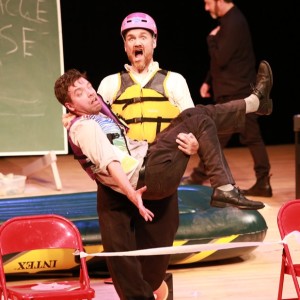
Genre: Comedy
Explore this module
Introduction
Thousands of years old, comedy seeks to entertain the audience through laughter. But, comedy has also had several variations throughout theatre history, from teaching the audience moral lessons to making fun of popular social issues to simply getting people to laugh. Present-day comedy has a wide range of styles and practices--all informed by the history of comedy and how writers have used it. This guide will provide both an overview of the types of comedy in theatre, as well as how comedy has been used for a larger purpose.
Terminology
- City Comedy: A type of comedy popular in the English Renaissance, set within London with middle-class characters and domestic conflicts.
- Comedy of Manners: A type of comedy, popular in the English Restoration, that made fun of social norms and mores.
- Commedia dell’arte: In the Italian Renaissance, a professional troupe of actors that used stock characters and lazzi to create entertaining stories.
- Dark Comedy: Also called “black comedy,” takes a pessimistic view of the world.
- Farce: A type of comedy that uses exaggeration, often with clowning and ridiculous behaviors, in order to entertain.
- Lazzi: Short comic bits used in commedia dell’arte.
- Parody: A type of comedy that uses imitation of a person or situation.
- Pastoral Comedy: Popular in Renaissance England, stories set in the countryside, often with shepherds.
- The Poetics: Ancient treatise by Aristotle that sets out the rules of dramatic poetry, including comedy and tragedy.
- Satire: A form of comedy that presents ridiculous extremes in order to make a point about society or human nature.
- Sentimental Comedy: A type of English comedy popular in the 1700s that was intended to teach a moral lesson to the audience.
- Slapstick: A type of comedy that uses physical gags.
Context & Analysis
Generally, the structure of comedy is a movement from chaos into order. While the characters and exposition of the play may start off calm and ordered, something happens that throws everything into a hectic spin. This conflict must be sorted out, and order returned. Throughout a comedy, writers create witty language and jokes, while actors bring the characters to life
to read our learning module for Genre: Comedy and to unlock other amazing theatre resources!StageAgent Resources
StageAgent Sections
Guides
Writer Guides:
- Aristophanes
- Plautus
- Terence
- Shakespeare
- Moliere
- Carlo Goldoni
- Stephen Sondheim
- Tom Stoppard
- George S. Kaufman
- Moss Hart
Show Guides:
- Lysistrata
- As You Like It
- A Midsummer Night’s Dream
- She Stoops to Conquer
- Tartuffe
- The Country Wife
- One Man, Two Guv’nors
- A Funny Thing Happened on the Way to the Forum
- Rosencrantz and Guildenstern Are Dead
- Arsenic and Old Lace
- You Can’t Take It With You
Theatre History:
- Ancient Greek Theatre
- Ancient Roman Theatre
- Commedia dell’arte
- English Renaissance
- French Neoclassical Theatre
- English Restoration Comedy
- English Sentimental Comedy
Performing Guides:
Blog Posts
Links & Media
Quizzes

Cindi Calhoun
Theatre teacher, director, writer, and seamstress